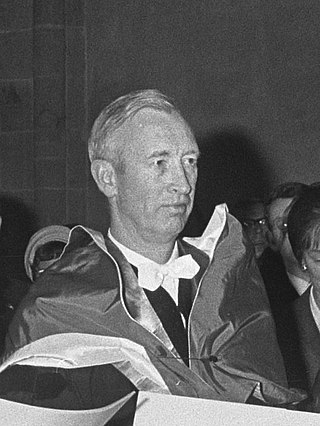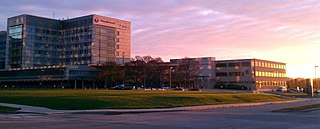Related Research Articles

Worcester is a city in and the seat of Worcester County, Massachusetts, United States. Named after Worcester, England, the city's population was 206,518 at the 2020 census, making it the second-most populous city in New England after Boston. Worcester is approximately 40 miles (64 km) west of Boston, 50 miles (80 km) east of Springfield and 40 miles (64 km) north-northwest of Providence. Due to its location near the geographic center of Massachusetts, Worcester is known as the "Heart of the Commonwealth"; a heart is the official symbol of the city.

Shrewsbury is a town in Worcester County, Massachusetts, United States. The population was 38,325 according to the 2020 United States Census, in nearly 15,000 households.

Gregory Goodwin Pincus was an American biologist and researcher who co-invented the combined oral contraceptive pill.

The University of Massachusetts is the five-campus public university system and the only public research system in the Commonwealth of Massachusetts. The university system includes five campuses, a satellite campus in Springfield and also 25 campuses throughout California and Washington with the University of Massachusetts Global.
The University of Massachusetts Chan Medical School is a public medical school in Worcester, Massachusetts. It is part of the University of Massachusetts system. It is home to three schools: the T.H. Chan School of Medicine, the Morningside Graduate School of Biomedical Sciences, and the Tan Chingfen Graduate School of Nursing, as well as a biomedical research enterprise and a range of public-service initiatives throughout the state.

The Hoagland-Pincus Conference Center is a conference facility of the University of Massachusetts Medical School.

Paul Charles Zamecnik was an American scientist who played a central role in the early history of molecular biology. He was a professor of medicine at Harvard Medical School and a senior scientist at Massachusetts General Hospital. Zamecnik pioneered the in vitro synthesis of proteins and helped elucidate the way cells generate proteins. With Mahlon Hoagland he co-discovered transfer RNA (tRNA). Through his later work, he is credited as the inventor of antisense therapeutics. Throughout his career, Zamecnik earned over a dozen US patents for his therapeutic techniques. Up until his death in 2009 he maintained a lab at MGH where he studied the application of synthetic oligonucleotides for chemotherapeutic treatment of drug resistant and XDR tuberculosis in his later years.

Min Chueh Chang, often credited as M.C. Chang, was a Chinese-American reproductive biologist. His specific area of study was the fertilisation process in mammalian reproduction. Though his career produced findings that are important and valuable to many areas in the field of fertilisation, including his work on in vitro fertilisation which led to the first "test tube baby", he was best known to the world for his contribution to the development of the combined oral contraceptive pill at the Worcester Foundation for Experimental Biology.
Mahlon Bush Hoagland was an American biochemist who discovered transfer RNA (tRNA), the translator of the genetic code.

Hahnemann Hospital is a formerly independent hospital located in Worcester, Massachusetts. The facility is now part of the UMass Memorial Medical Center.

UMass Memorial Health (UMM Health) is the clinical partner of the University of Massachusetts Medical School and the largest healthcare system in Central Massachusetts. It is a not-for-profit/nonprofit healthcare network providing all levels of primary to quartenary healthcare.

Joan Massagué, is a Spanish biologist and the current director of the Sloan Kettering Institute at Memorial Sloan Kettering Cancer Center. He is also an internationally recognized leader in the study of both cancer metastasis and growth factors that regulate cell behavior, as well as a professor at the Weill Cornell Graduate School of Medical Sciences.

The University of Massachusetts Amherst College of Engineering is one of the schools and colleges at the University of Massachusetts Amherst. It was established on September 1, 1947 as the School of Engineering and now considered as the best public engineering school in New England, enrolling 2250 undergraduate students and 610 graduate students including 300 M.S. students and 310 Ph.D. students for the 2018–2019 school year. The College of Engineering at UMass Amherst has eight buildings, including the Elab II, research facilities, computer labs, and graduate offices. It has more than 16,000 living alumni around the world.
Katherine A. Fitzgerald is an Irish-born American molecular biologist and virologist. She is a professor of medicine currently working in the Division of Infectious Disease at the University of Massachusetts Medical School. She is also the director of the Program in Innate Immunity.

Angela Hartley Brodie was a British biochemist who pioneered development of steroidal aromatase inhibitors in cancer research. Born in Lancashire, Brodie studied chemical pathology to a doctoral level in Sheffield and was awarded a fellowship sponsored by National Institutes of Health. After 17 years of working in Shrewsbury, Massachusetts on oral contraceptives with Harry Brodie, whom she married, she switched focus to the effects of the oestrogen-producing enzyme, aromatase, on breast cancer.
Michael Green was an American molecular biologist and cell biologist at the University of Massachusetts Medical School, where he was the chair of the Department of Molecular, Cell and Cancer Biology, director of the UMass Cancer Center, and a Howard Hughes Medical Institute investigator. Green was a member of the National Academy of Sciences and the National Academy of Medicine.
Dorothy P. "Dori" Schafer is an assistant professor in the department of neurobiology at University of Massachusetts Medical School. Her research focuses on the role of microglia in the development of synapses and brain circuits as well as the maintenance of synaptic plasticity.
Phillip D. Zamore is an American molecular biologist and developed the first in vitro system for studying the mechanism of RNA interference (RNAi). He is the Gretchen Stone Cook Professor of Biomedical Sciences and Professor of Biochemistry and Molecular Pharmacology at University of Massachusetts Chan Medical School, located in Worcester, Massachusetts. Zamore is the chair of the RNA Therapeutics Institute (RTI) at UMass Medical School, established in 2009, and has been a Howard Hughes Medical Institute Investigator since 2008.
Patricia Kilroy Donahoe is an American pediatric surgeon and a leading researcher in the field of developmental biology and oncology. She was the president of the American Pediatric Surgical Association from 2006 to 2007. She currently serves as the director of pediatric surgical research laboratories and chief emerita of pediatric surgical services at Massachusetts General Hospital.
Hudson Hoagland was an American neuroscientist, president of the American Academy of Arts and Sciences, from 1961 to 1964.
References
- 1 2 "University of Massachusetts Medical School (UMass Medical School)". Umassmed.edu. 6 June 2013. Retrieved 25 June 2019.
- ↑ "Center for Mindfulness - UMass Medical School". University of Massachusetts Medical School. 9 September 2014. Retrieved 25 June 2019.
